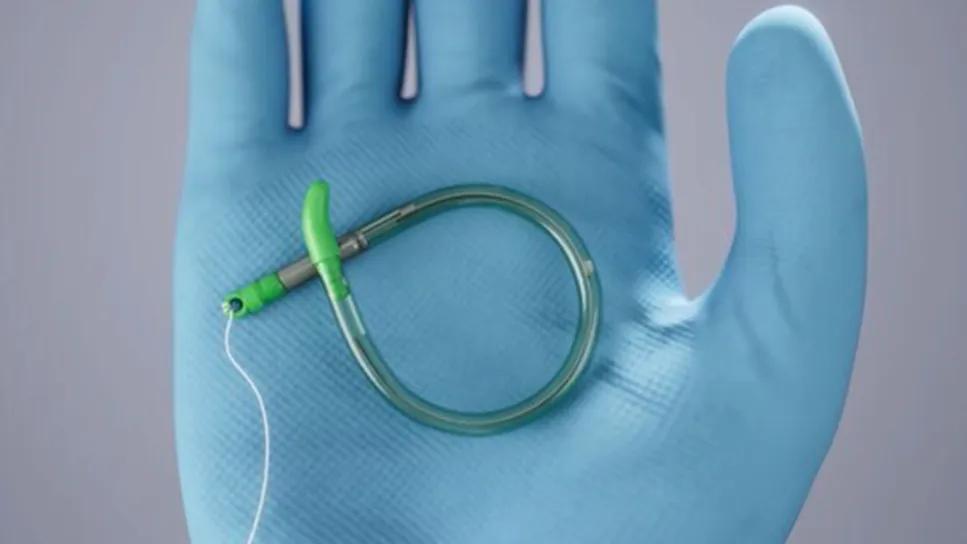Cleveland Clinic is first to use the device, known formerly as the UroMonitor

A novel, wireless ambulatory urodynamic system, engineered and tested by Cleveland Clinic researchers and physicians, is one step closer to commercialization. The device, now known as the Glean™ Urodynamics System, a product by Bright Uro, received 510(k) clearance from the U.S. Food and Drug Administration and was used for the first time in a Cleveland Clinic patient. These developments follow several years of clinical data demonstrating its safety and feasibility in women with overactive bladder (OAB).
Advertisement
Cleveland Clinic is a non-profit academic medical center. Advertising on our site helps support our mission. We do not endorse non-Cleveland Clinic products or services. Policy
The device was conceptualized by Cleveland Clinic biomedical engineer Margot Damaser, PhD, over 10 years ago to improve conventional urodynamics, the standard approach to bladder testing. The challenges of a catheter-based diagnostic approach are many, she explains.
In addition to what can be physically uncomfortable and embarrassing for many patients, emptying the bladder on-demand creates artificial data that may not be representative of patients’ symptoms. This can obfuscate the plan for care.
Urologist Howard Goldman, MD, adds, “It’s always frustrating when you have a patient with severe obstruction and no clear indication. In a lab setting, these symptoms may actually worsen for many people.” Dr. Goldman, a specialist in female urology and voiding dysfunction, has been the clinical lead on the studies evaluating the device.
The root cause of the problem is an important distinction. “Is there an obstruction, or is the bladder not functioning properly? Understanding this from a voiding standpoint is so critical and informs the next steps in management,” he notes.
Since the trial began enrolling participants two years ago, the device has been tested in more than 11 women with refractory OAB.* After conducting a baseline assessment using conventional urodynamics, investigators inserted the device transurethrally, as would be done in cystoscopy or catheter placement, using a silk suture attached to one end of the device and taped to the patient’s thigh for easy retrieval from the bladder.
Advertisement
“The device successfully captured 98% of voiding and nonvoiding urodynamic events,” notes Dr. Goldman. Equally important, patients reported minimal discomfort with the insertion. These findings suggest that extended monitoring times outside of a clinic setting are achievable and may yield higher satisfaction and better real-world data.
The team has also been studying the device in patients with a neurogenic bladder (N=10). Data show it was accurate, well-tolerated and, according to participants, preferential to conventional UDS in terms of comfort. The study, presented at the 2024 Annual American Urological Association, concludes that the device is a promising alternative to UDS in those with borderline obstruction or “shy bladders.”

The commercially available version is nearly identical to the prototype but boasts a sleeker aesthetic without an external radio, as required with Cleveland Clinic’s device.
The marketplace versions will also have an optional abdominal pressure sensor that is inserted into the rectum. This will be available in 2026. “Traditional urodynamics measures pressure in the bladder and abdomen with catheters and uses an algorithm to help evaluate. This is simply for clinicians who are used to this approach and like this extra data point, but not everyone will opt for this feature.”
It also has an integrated uroflow that measures the urinary flow rate, allowing clinicians to observe how it correlates with bladder activity. “With these two components,” Dr. Goldman explains, “we have essentially recapitulated standard in-office urodynamics but with the benefit of doing it at home.”
Advertisement
The device is approved for use within a clinical setting with more natural ambulatory movement. However, the goal is to extend use to an at-home, overnight setting.
The research opportunities abound, especially once the device is approved for home use, notes Dr. Damaser. “We can ask questions like, Do urodynamics reproduce pressures at home? Are the filling pressures similar? Are the voiding pressures similar? We don’t know.”
The new data could guide the management of bladder disorders in an entirely new way. Concludes Dr. Damaser, “If we can better classify bladder symptoms because of access to this richer data, can we potentially subclassify types of urinary incontinence and, therefore, be in a better position to treat it?”
*Editor's note: While the UroMonitor was tested in more than 11 women with refractory overactive bladder, Bright Uro has tested Glean in 40 patients, both men and women, to date.
Advertisement
Advertisement

Reproductive urologists publish a contemporary review to guide practice

Two recent cases show favorable pain and cosmesis outcomes

Meta-analysis assesses outcomes in adolescent age vs. mid-adulthood

Proteinuria reduction remains the most important treatment target.

IgA nephropathy is a relatively common autoimmune glomerular disease that can be diagnosed only by biopsy

Oncologic and functional outcomes are promising, but selection is key

First single-port renal vein transposition reduces recovery time and improves outcomes

Approach offers a ‘middle ground’ between radical prostatectomy and active surveillance